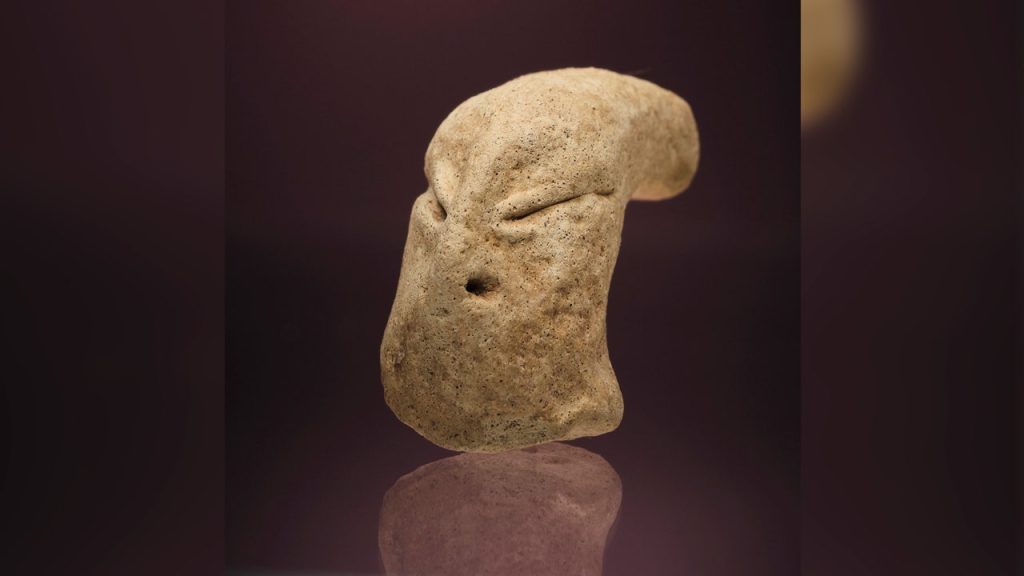The arid sands of Kuwait have yielded a remarkable artifact, a small clay head with alien-like features, dating back to the Ubaid period of ancient Mesopotamia, some 7,000 to 8,000 years ago. Unearthed by the Kuwaiti-Polish Archaeological Mission at the Bahra 1 site in the Subiya region, this enigmatic figurine has sparked intrigue among researchers, prompting questions about its purpose and the symbolic or ritualistic role it may have played within the ancient community. While similar Ubaid figurines have been discovered previously, this particular artifact marks the first of its kind found in the Persian Gulf region, adding a new dimension to our understanding of this ancient culture’s reach and influence. The figurine’s elongated skull, slanting eyes, and flat nose distinguish it from other artifacts of the period, further intensifying the mystery surrounding its creation and significance.
Beyond the captivating clay head, the Bahra 1 site has proven to be a treasure trove of archaeological discoveries, offering profound insights into the interplay between the Arabian Neolithic and Mesopotamian Ubaid cultures. Two distinct pottery types have been identified at the site: Ubaid ware, known to be imported from Mesopotamia, and Coarse Red Ware (CRW), characteristic of the Arabian Peninsula. The presence of CRW, previously thought to be locally produced in the Gulf region but with its origins unknown, has been definitively linked to Bahra 1, solidifying the site’s status as the oldest known pottery production center in the Persian Gulf. This discovery, marked by the presence of an unfired clay vessel, underscores the significance of Bahra 1 as a pivotal hub for ceramic production during the Ubaid period.
The identification of Bahra 1 as a pottery production site is not merely a matter of historical curiosity. It reveals a complex network of trade and cultural exchange that existed thousands of years ago. The presence of imported Ubaid ware alongside locally produced CRW suggests a vibrant interaction between the Mesopotamian and Arabian Neolithic cultures. This exchange of goods and ideas likely played a crucial role in shaping the development of both cultures, contributing to the rich tapestry of human history in the region. The discovery also provides valuable context for understanding the distribution and movement of goods and technologies during this period.
Further enriching the archaeological narrative at Bahra 1 are the small fragments of plants found embedded within the pottery. These botanical remnants offer a glimpse into the local flora of the time, providing clues about the environment and the resources available to the ancient inhabitants. Archaeobotanical analysis of these plant fragments will shed light on the types of vegetation present, potentially revealing insights into agricultural practices, dietary habits, and the overall ecological landscape of the region during the Ubaid period. This analysis will contribute to a more comprehensive understanding of the relationship between the ancient people and their environment.
The ongoing excavations at Bahra 1 promise to unveil further discoveries and insights, deepening our comprehension of the intricate connections between the Arabian Neolithic and Mesopotamian Ubaid cultures. The Kuwaiti-Polish Archaeological Mission is committed to continued exploration of the site, with the hope of uncovering more artifacts and evidence that will illuminate the cultural dynamics of the region. The team also aims to foster greater cooperation between Polish and Kuwaiti heritage specialists, ensuring the preservation and interpretation of these invaluable historical treasures.
The Bahra 1 site has emerged as a critical location for understanding the cultural exchange between Arabian Neolithic societies and the expansive Ubaid culture, which extended its influence from Anatolia to the Arabian Peninsula. The recent research conducted at this site has yielded unique discoveries, adding significant pieces to the puzzle of our understanding of this crucial period in human history. The unexpected discovery of the alien-like clay head, combined with the identification of Bahra 1 as a pottery production center and the potential insights from archaeobotanical analysis, highlights the remarkable historical significance of this site and the ongoing efforts to unravel its secrets.

